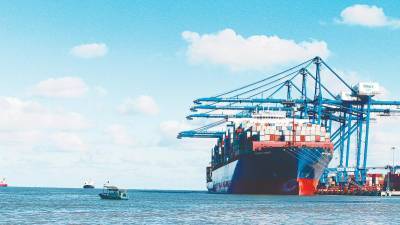SINGAPORE: Asia-US sea freight rates are set to drop further in 2025 as shipping capacity outpaces demand and trade routes shift due to tariffs and geopolitical tensions, though vessel rerouting is expected to limit some losses, industry experts said.
Average spot rates for containers from Asia to the US west and east coasts have slumped by 58% and 46% respectively, since June 1 and are expected to fall further, according to shipping analytics firm Xeneta.
Adding to uncertainty are unresolved trade talks between the US and China. Officials from the world’s top two economies last week agreed to seek an extension of their 90-day tariff truce. The China-US trade lane remains one of the most profitable for container ship operators.
Sea freight saw a brief uptick in late May and early June as shippers took advantage of a 90-day pause in US President Donald Trump’s tariffs, but rates quickly fell as capacity outweighed demand, Xeneta data showed.
“There is significant overcapacity globally and this will continue to shape the market,“ said Erik Devetak, Xeneta’s chief technology and data officer.
“China-to-US trade is dampened and the EU economy is not exactly hot, so blanked sailings and cancellations will become a recurring theme as carriers desperately try to keep freight rates up,“ Devetek said.
Blanked sailing refers to cancelled port calls or voyages.
Logistics major DHL noted that spot rates, which rose in the early summer surge of traffic from Asia to North America, have since reversed.
“Carriers rushed to add capacity on the transpacific to chase early gains, but oversupply is becoming apparent as the momentum fades,“ said Niki Frank, CEO of DHL Global Forwarding Asia Pacific.
Jarl Milford, maritime analyst at Veson Nautical, expects rates to decline steadily in the second half when more vessels are expected to enter the market.
“Ongoing uncertainty, including tariff policy and slowing global demand, adds continued pressure,“ Milford said.
Ocean Network Express, a joint venture between Japan’s Kawasaki Kisen Kaisha, Mitsui O.S.K. Lines and Nippon Yusen, said last week that “recent trade uncertainties further complicate visibility for the latter half of the fiscal year”.
A key factor helping absorb some of the excess capacity, however, is the rerouting of vessels from traditional sailings.
Carriers are diverting from the Red Sea following attacks by Yemeni Houthis, and some are bypassing US ports to avoid tariffs. These longer voyages are soaking up more ships and helping provide a floor for rates, analysts said.
“These diversions continue to soak up in excess of 10% of containership supply, leading capacity utilisation to a healthy level in the 86-87% range,“ analysts at Jefferies Research wrote, referring to the Red Sea.
And while China’s exports to the US have fallen, shipments elsewhere have climbed.
Jefferies analysts said spot bookings to the US in recent weeks suggest July volumes are likely to be down, pushing transpacific freight rates to their lowest this year, but rates to markets such as Europe and Latin America remain elevated. – Reuters
